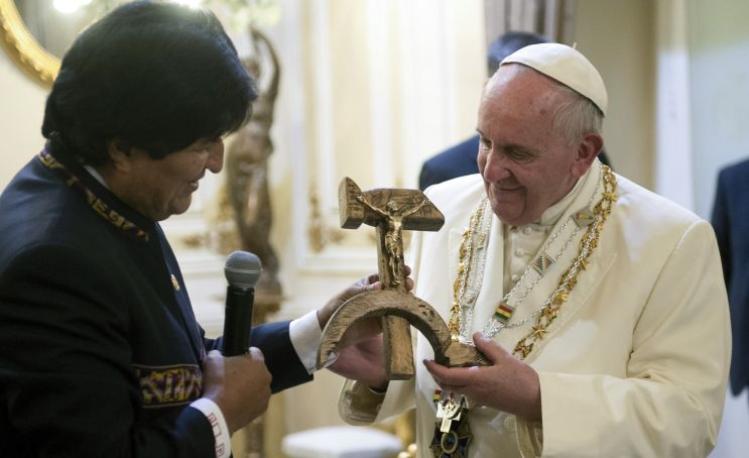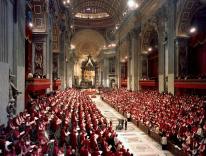
Outside of Bolivia, I don’t think many people knew of Luis Espinal before Pope Francis, during his recent visit to that country, stopped to pray at the site where Espinal’s body, riddled with bullets and showing signs of torture, was found in a landfill. Evo Morales, Bolivia’s first indigenous president, gave the pope a replica of a wooden crucifix that Luis had sculpted; it portrays Christ nailed to a hammer and sickle. This seemed a clumsy and controversial gesture, to say the least, implying that Espinal, an icon in the country’s struggle for democracy, was in fact a secret Marxist who would have supported Morales. This, at any rate, was the impression I had from the way the incident was presented by the media. I was disconcerted at first. This was not at all the Luis Espinal I knew.
I lived in Bolivia for five years and got to know “Lucho” Espinal fairly well. In fact, he is one of the godfathers of my son. In a corridor of our house hangs a wooden sculpture by Luis depicting the head and arms of the crucified Christ. Christ appears to be in a peaceful yet somehow painful sleep, all absorbed in his work of redemption. It wasn’t hard to get to know Luis: he was a very simple and unpresuming person who always seemed to be available for anyone. At that time he was known mostly as a film critic and taught communications in the Catholic University of La Paz. His main interest was the media. He lived with two other Jesuits in a very simple dwelling in one of the poorer districts of La Paz.
To understand Luis, it is important to situate him in the context of his times. The day I arrived in La Paz in 1974, the big news was that Hugo Banzer’s government had ordered the suppression of the Justice and Peace Commission of the Bolivian bishops conference. The priest in charge of the commission was expelled from the country. The church, accused of fomenting social unrest and encouraging subversion, was deeply divided. The Bolivian Constitution still recognized Catholicism as the official religion, and the state promised to favor and protect it. (This changed a few years ago, when Bolivia became secular state after a referendum.) In return for this privileged status, the church had the obligation to cooperate with and support the state. Under Banzer, the military ruled by decrees; political parties and trade unions were banned. The Justice and Peace Commission was the only organization that had dared to criticize the government. With its suppression, tranquility was restored—but it was the tranquility of a graveyard. A large part of the clergy and hierarchy were satisfied with this: as long as they behaved and stuck to administering the sacraments and overseeing popular devotions, they were considered to be doing God’s work and had it pretty good. But underneath it all, there was deep frustration and humiliation. Elements of the clergy were shocked by the dismal conditions and thousand little tyrannies to which the people were submitted. Many foreign priests, in particular, were unaccustomed to dealing with such situations and felt they could not cooperate with policies and practices so offensive to simple human dignity. Luis was Spanish but totally devoted to the poor of Bolivia; he had renounced his Spanish citizenship and was a naturalized Bolivian.
A turning point came in 1978 when Adolfo Pérez Esquivel, the future Nobel Peace Prize recipient, visited La Paz. At that time he was head of what was called the Peace and Justice Commission of Argentina, a human-rights advocacy group. He quietly proposed to set up a similar group in Bolivia. Jimmy Carter had been elected in the United States and was championing human rights, and it was widely felt that if we could put together an organization dedicated exclusively to human rights, the military would probably not dare to attack it. It was also important that such a group be totally independent of the church and its hierarchy. The new group would be a voice for the oppressed, their only voice. A few months later a delegate of Pérez Esquivel came to La Paz and helped us organize. He did a remarkable job; within a week the Permanent Assembly for Human Rights had become a reality. Luis was part of the project, but he was not offered a leadership role—nor would he have wanted one. That would have been totally out of character for him.
The new Human Rights Assembly set itself very modest goals at the beginning. It was not at all prepared when a group of women whose husbands had been jailed showed up and announced that they were going on a hunger strike and planned to install themselves in the bishop’s residence. Members of the Assembly tried to dissuade the women, telling them it would be pointless at this stage of the game. The women’s reply was simple: “We didn’t come here looking for advice or even support. We are simply telling you what we are going to do whether you like it or not. Our husbands are in prison, we don’t have anything to eat anyway so we might as well fast publicly.” There were three women and perhaps ten children in the group. When, after a few days, it became obvious that this was very serious and the children still refused the food the bishop had sent them, ten members of the Assembly offered to replace the children and this was accepted by the mothers. Luis was among those who offered themselves. The new group set up shop in the offices of Presencia, a Catholic daily newspaper, not particularly known for its opposition to the dictatorship. Hunger strikes soon began to break out all over the country. After about two weeks, the government broke into the newspaper offices and forcibly removed the hunger-strikers. The authorities claimed they found plenty of food, liquor, and drugs on the premises, and that the whole thing was a farce. Unfortunately for the government, a television station, alerted to the raid, had the whole thing filmed and broadcast. The footage showed people being carried out on stretchers, too weak to walk and singing the Beatitudes. About a week later, Banzer announced that he was resigning, and that elections would be held.
The transition to democracy after years of a totalitarian dictatorship was not easy, and for a long time the situation was chaotic. During this period, Luis launched a weekly newspaper called Aqui, which was a voice of sanity and clarity in the middle of all the confusion. He continued to teach at the Catholic University. He was a poet and an artist, with a very acute sensitivity and a genuine love for the oppressed and humiliated. On March 21, 1980, he was kidnapped a few blocks from his house. Someone heard him cry, “This is it!”—as if he was expecting it. His body was found the next morning.
They say that after the death of Benedict Joseph Labre—a homeless beggar and mystic who lived among the ruins of the Roman Colosseum—the people of Rome proclaimed him a saint before he was even buried. Something similar happened to Luis. He was not particularly well known, not much of a public figure, but the whole city of La Paz shut down for his funeral. The largest crowd I’d ever seen accompanied Luis’s body from the cathedral to the cemetery, some singing hymns and praying, others shouting political slogans. Luis had touched something deep in the hearts of the Bolivian people he loved so much, and they recognized their purest aspirations in him. Their affection and gratitude has not faded with the passage of time. Streets, markets, and schools have been named in his honor. You can’t go far in La Paz without seeing his name.
Luis did not belong to any political party. Nor was he part of any organized “movement.” He was a man of peace and dialogue. There was even something a bit timid about him; he never imposed himself and would render little services without being asked. There was an unmistakable purity in him, and this purity was truly revolutionary.
But it would not surprise me if, given the situation at the time, Luis had seen in Marxism Gospel values that were sorely lacking in certain sectors of the church, and believed that these values could and should be incorporated into a Christian vision of society. That he should have such sentiments seems almost natural. I had them myself at the time. In Latin America, Marxism took many forms; it was not identified only with the Communist Party. In fact, the bona fide Communist parties I knew in Latin America were little self-enclosed cliques with little popular support. There was a need for some sort of collaboration with what was best in the left-wing parties. That seemed indispensable if real change were to come about.
When Pope Francis was questioned about the “strange” gift of the “Marxist Christ,” his response clarified the real significance of the sculpture. The pope, unlike myself, seems to have gotten it right away. Just as those who tried to live the Beatitudes were automatically branded “Marxists” by the powerful and comfortable, Christ too might have been crucified as a Marxist, branded with the stigma of the hammer and sickle, with all its connotations of hatred and destruction. It is a very powerful and provocative challenge. There are not lacking voices today, in this country and even in the church, similarly branding Pope Francis a “Marxist” (for example, Rush Limbaugh). Bishop Romero was assassinated three days after Luis for being a “Marxist”; Dorothy Day was considered a Communist; Thomas Merton, a subversive. Time has shown them to be prophets, ahead of their time. “By their fruits shall you know them.”
What Pope Francis, the “Marxist pope,” is doing for the church is the stuff Luis dreamed of. And I think that Pope Francis, who certainly knew Luis, is well aware of that. It was people like Luis who went to the peripheries and prepared the way.

